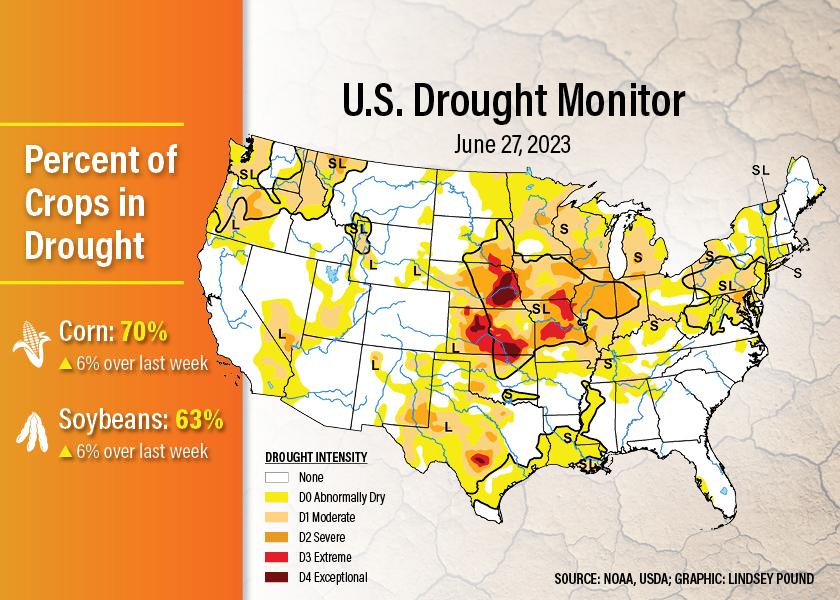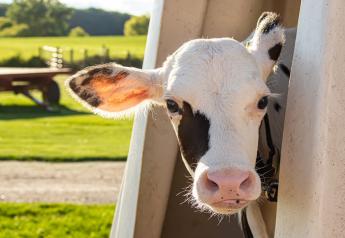Recent Rains Didn't Put a Dent in the Midwest Drought, 70% of U.S. Corn Crop Now Hit by Drought

It’s now estimated 70% of the U.S. corn crop and 63% of soybeans across the U.S. are covered in drought. While the latest U.S. Drought Monitor shows drought expanded across Illinois and Indiana over the past seven days, increased chances of rain across the Corn Belt, including those two states, could hit at a critical time.
National Drought Mitigation Center keeps track of the percentage of growing area affected by drought. Last week, 64% of corn and 57% of soybeans were impacted by drought. This week's updated look showed a 6-point expansion for both corn and soybeans.
Even with rains sweeping the Northern Corn Belt last weekend, the latest drought monitor shows drought continues to spread across Illinois. The Monitor shows D2 (Severe Drought) conditions, taking a considerable jump in Illinois this week. Severe drought covers nearly 59% of the state, up 28 percentage points in just a week. The amount of the state considered abnormally dry is 92%, up 10 points in a week.
Missouri is also seeing the impacts of drought take a toll across the state. D3 (Exceptional Drought) spans across nearly 20% of the state, up from 15.7% last week. D2 (Severe Drought) is covering more than half of the state, close to a 10-point spike in a week.
Across the entire Midwest, the Drought Monitor shows:
- 64.71% of the Midwest is D1/Abnormally Dry, a 6 point increase 64.71, was 58.49
- 24.65 is D2, severe drought, up nearly 9 points
- D3 (Exceptional Drought) increased to 3.52%, up from 2.59% last week

According to the authors of this week’s drought update, there were widespread changes across the U.S., including heavy rains in the Northeast.
“The Midwest and east-central Great Plains saw mostly worsening conditions and widespread crop stress and low streamflows after another week of mostly dry weather. A mix of improvements and degradations occurred in Texas, where recent precipitation amounts have varied widely. The northern Great Plains received widespread heavy rainfall this week, leading to large-scale improvements to ongoing drought and abnormal dryness. In the Pacific Northwest, a few areas saw above-normal precipitation and improving conditions, but larger parts of the region saw increasing evaporative demand, continued dry weather and lowering streamflows, leading to worsening conditions.”
The authors noted heavy rains hit parts of Ohio and Kentucky, which did improve long-term drought, but much of the region also saw conditions worsen, including in central Indiana, Illinois, Missouri, southwest Wisconsin, southeast Minnesota and southeast Iowa.
“Almost completely dry weather in Missouri and the southern two-thirds of Illinois led to widespread degradations, where streamflow and soil moisture continued to decrease amid mounting precipitation deficits, creating potential problems for corn and soybean production this growing season," the Drought Monitor stated this week. "In Missouri, cold weather in December and April have combined with the ongoing drought to lead to a 70% reduction in wine production. Hay production in Missouri was also reported to be one-third of normal. In southeast Iowa, producers reported rolling corn leaves and stunted soybean plants. In the Upper Midwest states, strawberry production was also struggling.”
According to USDA-NASS, corn condition ratings across the U.S. dropped to only 50% in good to excellent condition this week. The five-point decline in a week’s time means this year’s corn crop has only been rated worse one other time in history: 1988.
That’s also a change from last week, when both 1992 and 1988 held the record for lower ratings.
Heading into the weekend, farmers across key areas of the Corn Belt hoped for rain. Instead, the system stayed north, producing decent rainfall for parts of South Dakota, Iowa and northern Illinois. It wasn’t enough to save the corn crop, with more weekly drops in the following states:
- Illinois: 26% good to excellent, down 10 points
- Indiana: 47%, down 9 points
- Iowa: 56%, down 3 pointes
- Missouri: 31, down 12 points
- Nebraska: 57%, down 2 points
- South Dakota, 47%, down 1 point
Drought Sprouts Corn Yield Concerns
The drought is stirring up debate on the impact on overall crop production and yield across the U.S. A recent AgWeb found 61% of respondents are getting more worried by the day when it comes to corn yields. 25% aren't sure. 15% say they are feeling good about current yield potential.

USDA currently has a 181.5 bu. per acre national yield penciled into their report. The next WASDE will be released be released July 12th, which will be the next opportunity to update its yield forecast.
It's still early enough for the nation's soybean crop to recover with any rains over the next couple of months, but USDA-NASS field reporters are also growing less optimistic about the U.S. soybean crop. Soybean crop condition ratings are currently the second-worst on record, only behind 1988, with 51% of the crop rated good to excellent. That's a three-point drop in a week.
Better Chances of Rain on the Way
USDA meteorologist Brad Rippey says topsoil moisture is still an issue, especially across Illinois and Missouri that saw very little rain in the storm system that swept the Corn Belt last weekend. However, he does think there are better chances of rain on the way for areas of the Midwest.
"As we move through the rest of this week and into the weekend, we have a little bit of good news for parts of the Corn Belt, and that is the block that has been dominating weather patterns across the Midwest for the better part of two months, has shown enough weakness to allow some moisture and energy to break through and work its way across the Midwest," says Rippey. "Now as we move through the next five days, it looks like the best opportunity for drought easing rainfall will occur generally across the southern part of the Corn Belt. So a band along an axis stretching from the central Great Plains into the Ohio Valley, that general area, which does include some of our driest areas in northern Missouri and Illinois, could see as much as one to three inches of rain."
He says the rain totals will be highly variable just due to the nature of precipitation this time of year.
"But at least there is a promise as we head into reproduction for corn and soybeans, of getting some one to three inch rainfall totals across the southern tier of the Corn Belt," he says.
Rippey says it's also key to keep in mind the moisture deficit many fields are facing, which means one to three inches of rain sounds like a dream of a forecast, but it won't have a dramatic change on the drought that continues to park itself and grow deeper in parts of the Midwest.
He says more rains are needed at such a crucial time of the production cycle, especially considering farmers in the Midwest typically see 1 to 1 1/3 inches of rain every week. He points out that moisture is needed to aid the crop during such a critical time of the crop production cycle.
ROLL CALL: How do crops look in your area? Post a comment or photo in Crop Comments.







